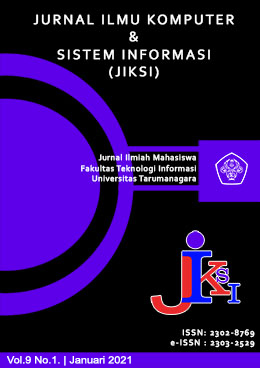PENGGUNAAN SPELLING CORRECTION DENGAN METODE PETER NORVIG DAN N-GRAM
Main Article Content
Abstract
Typing errors in a document are human errors that are difficult to avoid as a result of which the message to be conveyed is not optimal. Using the Spelling Corrector feature is one way to check typing errors. The Spelling Corrector feature is able to provide only one word suggestion and correct it immediately. The combination of Peter Norvig and Ngram's methods was able to come up with one word suggestion and correct it right away. Both methods of looking for word suggestions use the probability value of the words that appear most frequently in the dictionary. The difference between the two methods is that Peter Norvig uses an algorithm that combines the delete, insert, replace, and transpose processes for the wrong word. Meanwhile, Ngram uses an algorithm that pays attention to the words before and after them based on the sentences in the dictionary. The dictionary used is a dictionary of word lists from KBBI and also a dictionary of sentences taken from several articles on the internet. This combination of methods was tested using 55 documents containing sentences that had one misspelled word. The test results show that the combination of the two methods provides an accuracy rate of 73,684% and a success rate of 37,037% for the total accuracy of this application is 69.09%. These two methods can be used to correct typing errors, although they cannot correct words with an error rate of two or more letters. This is because Peter Norvig was unable to correct a word with a two-letter error rate and needed a good corpus.
Article Details
This work is licensed under a Jurnal Komunikasi Creative Commons Attribution-ShareAlike 4.0 International License.
References
Mutammimah; Sujaini, Herry; dan Nyoto, Rudy Dwi. “Analisis Perbandingan Metode Spelling Corrector Peter Norvig dan Spelling Checker BK-Trees pada Kata Berbahasa Indonesia (Studi Kasus: Universitas Tanjungpura)”. Jurnal Sistem dan Teknologi Informasi. Vol. 5, Nomor 1. Pontianak: Fakultas Teknik Universitas Tanjungpura, 2017.
Augusfian, Fendy; M. Viny, Christanti; Hendyli, Janson; dan Naga, Dali S. “Sistem Pengoreksian Ejaan Bahasa Indonesia dengan Damerau Levenshtein Distance dan Recurrent Neural Network (Studi Kasus: Universitas Tarumanagara)”. Journal of Computer Science and Information Systems. 3/2, hlm. 144-152. Jakarta: Fakultas Teknologi Informasi Universitas Tarumanagara, 2019.
Maghfira, Trusty Nadia; Cholissodin, Imam; dan Widodo, Agus Wahyu. “Deteksi Kesalahan Ejaan dan Penentuan Rekomendasi Koreksi Kata yang Tepat Pada Dokumen Jurnal JTIIK Menggunakan Dictionary Lookup dan Damerau-Levenshtein Distance (Studi Kasus: Universitas Brawijaya)”. Jurnal Pengembangan Teknologi Informasi dan Ilmu Komputer. Vol. 1, Nomor 6. Malang: Fakultas Ilmu Komputer Universitas Brawijaya, 6 Juni 2017.
Gusdiwangsa, Rangga. “Perbaikan Kesalahan Ejaan Dengan Metode Symspell Pada Kasus Tanya Jawab Dalam Bahasa Indonesia”. Jurnal Universitas Komputer Indonesia. bab 2, h. 10. Bandung: Universitas Komputer Indonesia, 2019.
Simajuntak, Maya Salinka; Sujaini, Herry; dan Safriandi, Novi. “Spelling Corrector Bahasa Indonesia dengan Kombinasi Metode Peter Norvig dan N-gram (Studi Kasus: Universitas Tanjungpura)”. Jurnal Edukasi dan Penelitian Informatika. Vol. 4, Nomor 1. Kalimantan Barat: Universitas Tanjungpura, Juni 2018.



